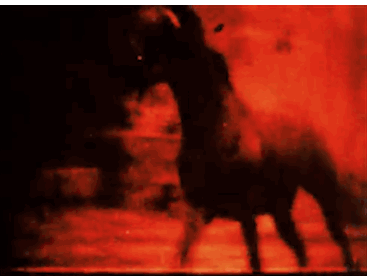
‘Born in Plymouth in 1940, Malcolm LeGrice is probably the most influential modernist filmmaker in British cinema. LeGrice’s work has explored the complex relationships between the filmmaking, projecting and viewing processes which constitute cinema as a medium, and shows an intense interest in the processes enabled by optical printers and by the combination of different types and gauges of film stock.
‘He started out as a painter in London in the early 1960s and turned to filmmaking in the middle of the decade with the Super-8 film China Tea (1965), which he followed with Castle 1 and Little Dog For Roger (both 1966), made mostly from re-worked found footage. Castle 1 can be seen as prophetic: for screenings of the film in 1968, LeGrice hung a light bulb next to the screen, flashing on and off at regular intervals and, when on, obliterating the screen image, a practice used in Martin Creed’s Turner-prize winning installation some 35 years later.
‘In the ’60s his work was informed by the radical politics of the period in opposition to the Vietnam War and US cultural imperialism, and extended to a deep hostility towards the ‘illusionism’ of Hollywood and other commercial cinemas. This tendency was particularly manifest in Spot the Microdot or How to Screw the CIA (1969), which includes found footage of GIs in battle. But LeGrice’s approach to cinema was also animated by a modernist impulse to put the central focus on the properties of the medium itself, turning them into the ‘content’ of the work. For instance, in White Field Duration (1972-73), a white screen marked only by a scratch running across clear celluloid, activates an intense perception of projection time. This film was also performed as a two-screen event and LeGrice’s installations at times extended to four or even six screens. From the late-sixties onwards, his multiple screen work was often accompanied by live performances interacting with the projection event (Horror Film 1 (1971) and Horror Film 2, (1972)).
‘LeGrice’s best and most complex work was done in the ’70s when, in the face of an intense hostility towards narrative cinema manifested by some of his avant-garde colleagues, he made a trilogy – Blackbird Descending (1977), Emily (1978), and Finnegans Chin (1981) – which elaborated a critical kind of storytelling in which both the formal aspects of cinema and the very structures of narrative are explored in relation to each other: The films are set in the film-maker’s own domestic environment and achieve a combination of intellectual and aesthetic intensity rarely seen in any kind of British cinema. LeGrice also engaged with art history (After Manet (1975), After Leonardo (1973)) and with the pioneers of cinema (After Lumière (1974) and Berlin Horse (1970) – in which he included a re-filmed Hepworth film of 1900, The Burning Barn).
‘In addition to being a prolific filmmaker, LeGrice played an influential role in the critical and institutional promotion of avant-garde cinema in Britain. He was a prominent activist in the Drury Lane Arts Lab, where he formed Filmaktion with William Raban, Annabel Nicolson, Gill Eatherley, Mike Dunford and David Crosswaite, and organised mixed-media shows. He was also a pioneer in the educational domain, initiating the trend towards establishing filmmaking sections in art colleges, a policy that bore fruit in the 1980s as new generations of filmmakers emerged from these courses. He is also an inveterate polemicist: his book, Abstract Film and Beyond, provides both a historical and a philosophical context for the British and European avant-garde cinemas, and he has contributed regularly to the journal Studio International.
‘LeGrice carried out the first experiments with computer-based film making in Britain (Your Lips 1 (1970)), and though it was a preoccupation that he laid aside after 1971, it came to dominate his media practice (along with research into digital art) from the 1980s onwards. Since 1997 he has headed the media research programme at Central St Martin’s art college in London, accompanying his activities with critical-historical reflections.’ — Paul Willemen
____
Stills
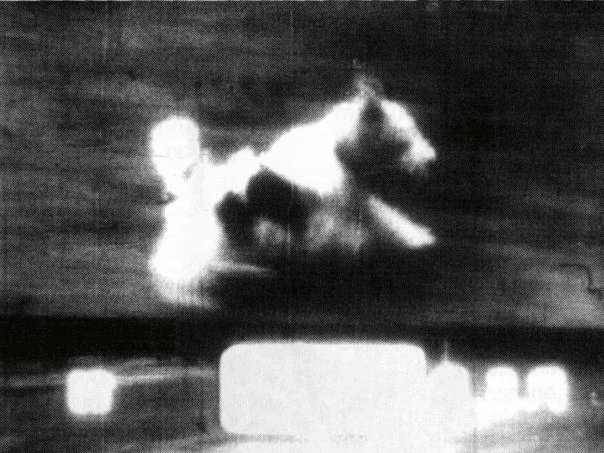
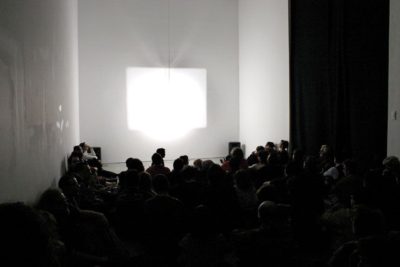

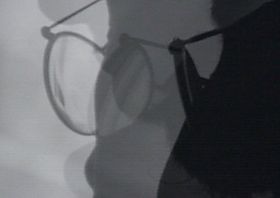
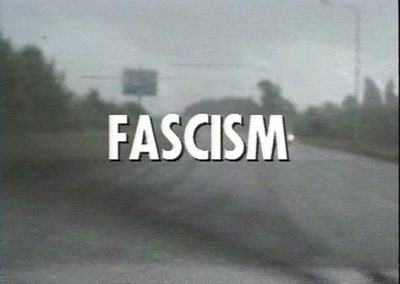
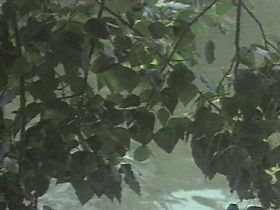


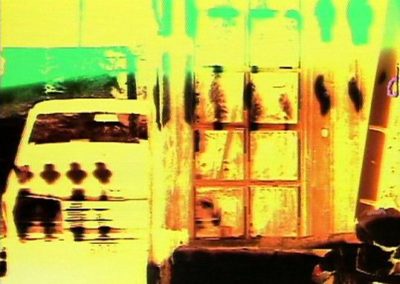
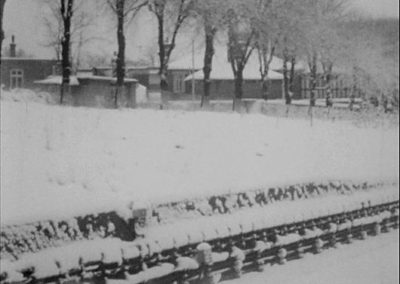
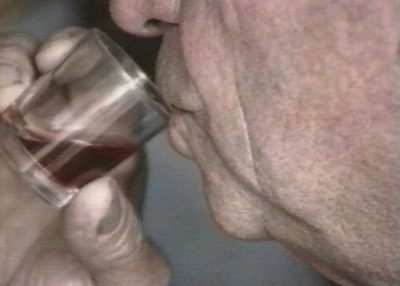

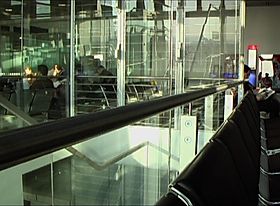
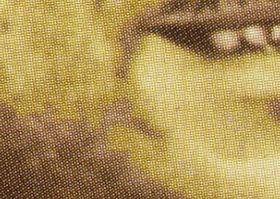

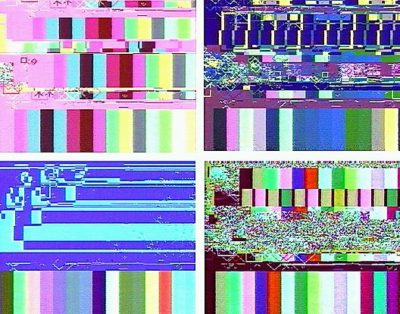
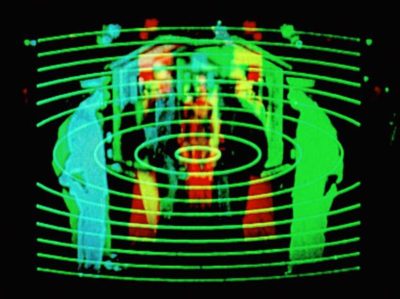
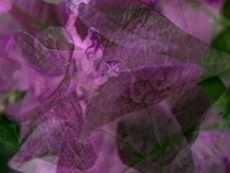
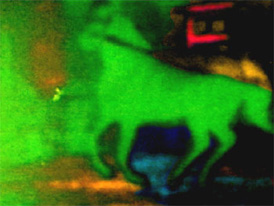
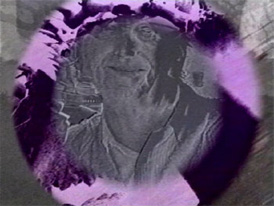
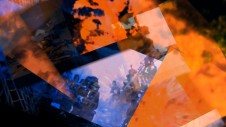
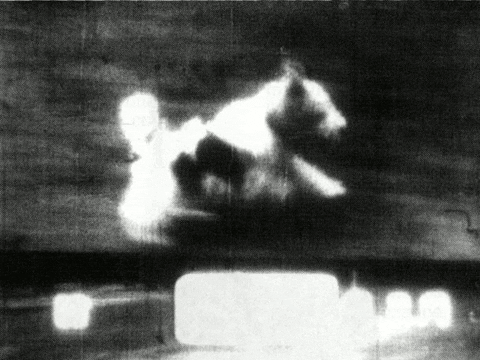

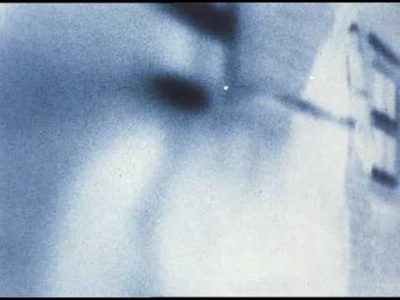


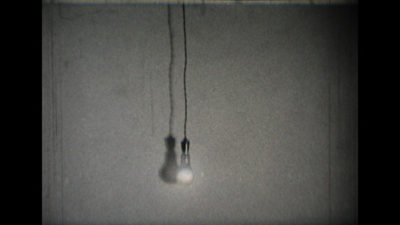
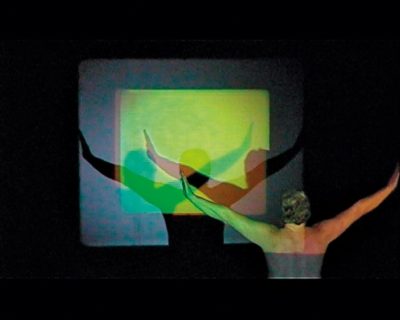
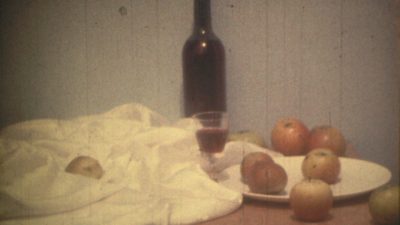



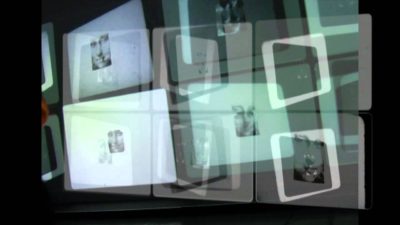

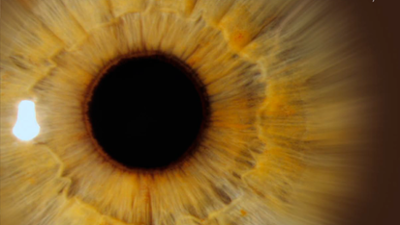

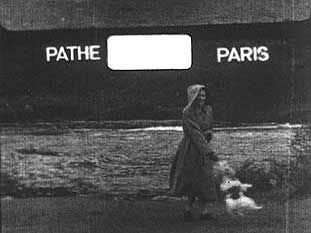



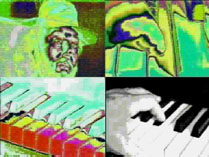
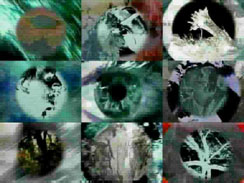
_____
Further
Malcolm Le Grice Site
MLG @ Lightcone
MLG @ Richard Saltoun Gallery
Malcolm Le Grice: In the Cinema
Multi Screen Improvisation Performed by Malcolm Le Grice and Keith Rowe
Malcolm Le Grice: Present Moments and Passing Time
MALCOLM LE GRICE’S ‘BERLIN HORSE’ @ desistfilm
MLG @IMDb
Muybridgean Motion/Materialist Film: Malcolm Le Grice’s Berlin Horse
“Discourse” versus “Medium”. Interview with Malcolm Le Grice
Beyond Abstract Film, on Malcolm Le Grice
MLG’s books @ goodreads
DVD: Afterimages 1: Malcolm Le Grice Volume 1
‘Abstract Film and Beyond’, by Malcolm Le Grice
After Le Grice: on inciting a new culture and infiltrating institutions
Malcolm Le Grice @ letterboxd
MLG @ MUBI
An Analysis of the Soundtrack in the Work of Malcolm Le Grice
_____
Extras
Malcolm Le Grice February 11, 2019, LA Filmforum
Horror Film (Malcolm Le Grice, 1972/2014)
Arts/Sciences#14: Malcolm Le Grice – Spectator, Presence and Encounter
_______
Interview
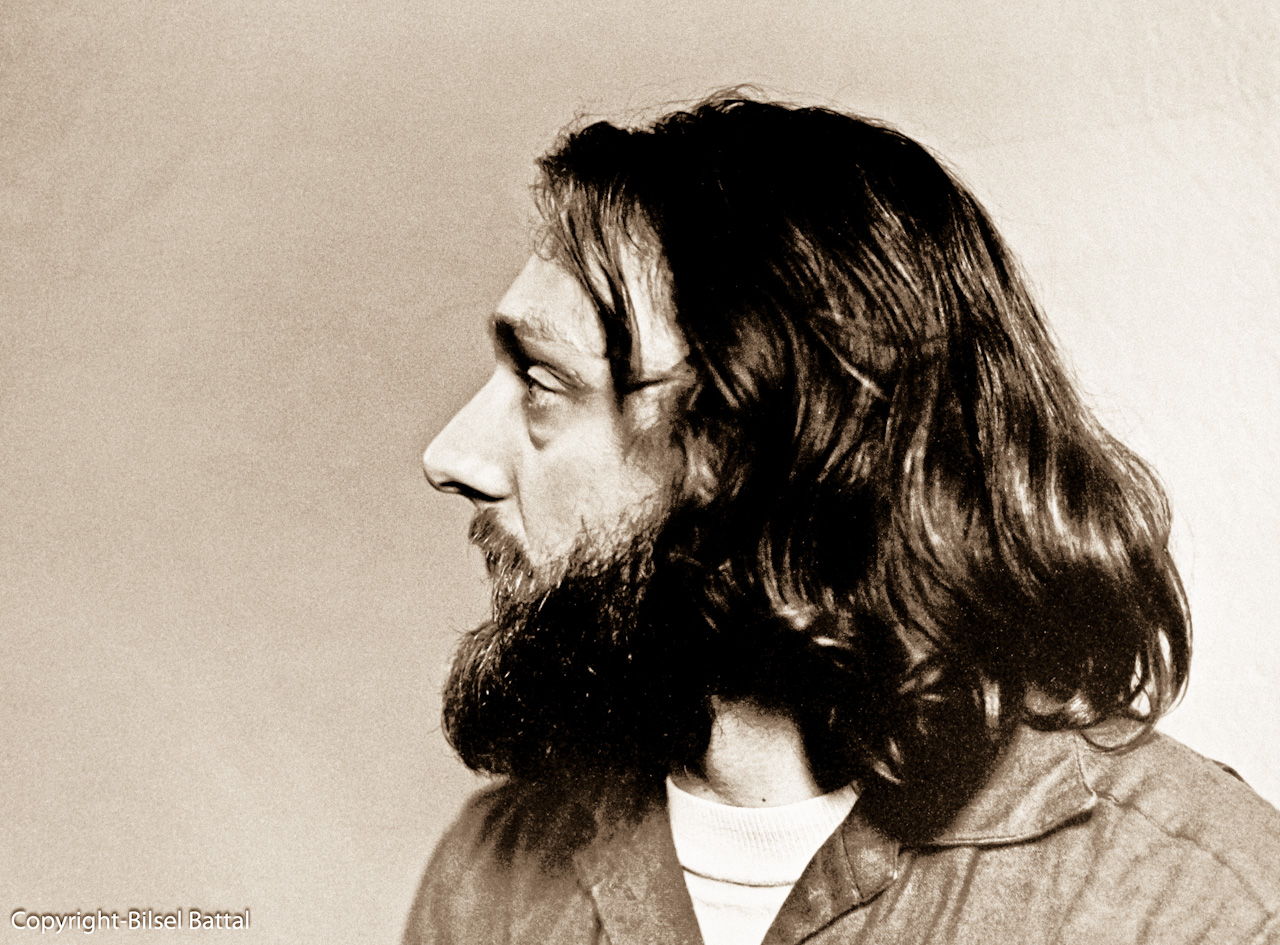
D: You were actively involved in the film cooperative movement in the sixties. Could you describe your relationships to the London Film Coop, founded in 1966, and how it interacted with your own practice of expanded cinema?
MLG : Your simple question is not really so simple.
I had started making films just before the London Film Makers Cooperative (LFMC) was formed. I began making films as one part of my movement from painting into other art media – including electronic technology and computers. When I made my earliest 8mm films in 1965 I did not know about the Underground cinema in the USA nor the New York Co-op. At that time I also did not know of the early avant-garde cinema – I only started to research that after making my first films.
The origins of an experimental film scene in London in the late 1960’s were also complicated. My first and main contact was not with the LFMC but with the first Arts Laboratory in Drury Lane, London set up by Jim Haynes, and where an old artist friend, David Curtis, had started a basement cinema. From 1967 I showed my work there and quickly, helped by Curtis’s programme, learned about the American and European experimental cinema. At the same time a group of people who wanted to be film- makers began the LFMC. But at that time it was only a distribution organization, showing occasionally at Better Books, a radical bookshop run by Bob Cobbing.
At the Arts Lab, responding to a situation where there were almost no experimental film-makers working in London – partly because of the cost of making 16mm films – Curtis and I developed the idea of establishing a film-makers workshop. I started to put this into practice by making home-made film printing and developing equipment. Though this worked for me and I made almost all my earliest 16mm films on it, it was too fragile and temperamental for other film-makers to use.
During 1968 it became clear to a number of people that it was crazy to have two organizations for experimental film in London when there were so few film makers – so we set up a series of meetings where Simon Hartog from the LFMC and myself from the Arts Lab were asked to make a plan for merging the Co-op and Arts Lab film area. Hartog and I then made a plan and constitution for a new LFMC that would have a workshop and cinema as well as distribution.
Through a contact made by Curtis at the Arts Lab, we were given £3,000 by an American art enthusiast, Victor Herbert, and I bought some used but very good professional film laboratory equipment. The workshop was mainly based on a 16mm Debrie ‘step’ contact printer that we installed at the second Arts Lab incarnation. Though this Debrie was not strictly an ‘optical’ printer, it allowed all sorts of inventive ‘mis-use’ – printing loops, pulling film through the gate by hand, re-colouring with filters or making multiple exposures. This led me and others to explore a range of methods for transforming the film image. The workshop, together with a cinema in the same building, meant the LFMC really took off and became the main centre in London for experimental film screening and production.
D: So what about your own work and expanded cinema?
My expanded cinema direction really started at the first Arts Lab cinema in Drury Lane in ’67 and ‘68. Curtis had designed the space with a very wide screen – a plain large white wall -, a floor with no seats, but a carpet on soft foam and two 16mm projectors. I started to make double projection films partly because the space and two projectors were available there. A little later, the LFMC workshop meant we could produce films very cheaply using black and white Orwo film brought in from East Germany – made at the old Agfa factory under the communists long before the re-unification. This film material had a characteristic high contrast – an old newsreel quality that suited the political environment of London in the politically active period of 1968. The egalitarian core and lack of censorship of the film-coop movement that started with the NY coop also appealed to my ideological position. The London coop quickly developed not just as a centre of experimental film making but also a very active centre of debate about film, culture and its relationship to politics and ideology. In particular I was frequently in discussion with Peter Gidal, who established a definition of Structural Materialist Film – some of these were public debates and we both published theoretical and critical essays.
So – the coop was a major influence on the development of my practice as a film-maker. It provided a very active, energetic intellectual context as well as facilities for production, and in each new temporary building – moving frequently into low rent but short life buildings – the projection space was suitable for experimental forms of projection, shadow and other forms of performance, live music and improvisation.
If the co-op was a major influence, it would be wrong to see it as the only influence. As is well known, London in the 60’s was a hot bed of artistic and ‘life-style’ experiments coupled with politics and protest. There was an eager audience for the ‘underground’ and new forms of art and art fusions. In this environment I was not only involved with film but also experimenting with early, primitive video and particularly seriously with computers. I made various performances including a 3D shadow play and continued my link with experimental music and sound through occasional light and sound performance with the experimental music group AMM.
Tracing specific influences in such a multi faceted environment and historical period is not an easy task.
D: In a sense, it is this idea of a “multi-faceted environment” that offers an entry into your work with film, early video, performance, shadow plays and experimental sound. We would thus like to ask you how “expanded cinema”, the political atmosphere of the time and forms of “intermedia” work interacted with each other? Also, how this set of relationships can be found in your own early experiments with the moving image and sound?
MLG: It is very important to understand that in the late 1960’s many artists were breaking away from the constraints of a single traditional medium – Painting, Sculpture, Music for example. They were experimenting with other media and also with combining media. I now like to talk of this as combining ‘artistic discourses’ rather than media – particularly as almost everything in art production and art viewing is now mediated or re-mediated through a digital process – so what is significant is the combination of historical contexts of ‘language’ rather than the physicality of the ‘medium’.
As a painter and a student at the Slade School in London in 1964 I also became dissatisfied with the limits of painting and started to make work where the painting was only a surface linking to the reality in front of it – with flexible physical attachments and objects hanging in front from clips that could be changed and with microphones and flashing lights – the paintings became time works where the meaning happened subsequent to the work rather than through interpretation of the artist’s intention. So – it was more concerned with a philosophy about the spectator, presence and ethics than about representation, expression and aesthetics. Shifts in medium were not in themselves my main motivation – though Film became the main focus when I started to treat it as a live-performance and not a retrospective narrative. As so little work had been done historically using film in this way a big field of experiment opened up for me, and with the added advantage that it allowed me to combine my earlier involvement with improvised music with my visual (painterly) engagement.
During my period as an art student from about 1959 to 1964 I had also become ‘politicised’ but in a very particular way. In that period Britain was a very closed and hierarchical society – a condition that sadly seems to be rapidly returning now. The aristocracy and wealthy establishment working through public schools and closed Universities seriously inhibited social mobility and meritocracy. Reaction to this came at a number of levels. Changes in dress and life style hit a peak in the late 60’s side by side with the rise in a youth culture of rock music – these were revolutionary if only at the symbolic surface. More fundamental was the rise in left-wing politics pressing for working class equality that was intellectually Marxist but at the grass roots led to increasingly militant workers union activity. This itself was fuelled by the rift with an often incompetent managerial class who had achieved their positions through class contact rather than merit.
I had come into this from a curious provincial sub-working class background. Mine was a family without wealth or education but who were able to live from their wits and energy sometimes near legal borderlines. However they went frequently, and took me, to the theatre and played music. So when later I found myself in the context of the London melting pot of the ‘swinging sixties’, I shared a radicalized political position with a desire for artistic expression. But – and it is a major ‘but’ – these two aspects were never linked directly. I certainly never led my artistic production by any didactic political idea. The two things ran in parallel – an anti establishment politics and a radically experimental approach to art. If they came together it was in the development of an art theory gradually clarifying a spectator-based concept applied mainly in film. This theoretical development was strongly connected to the ideas being developed at the time by Peter Gidal that he called ‘Structural Materialism’. Again I should stress that when I made and showed work I did this from improvised ‘instinct’ within the discourse of the visual, rhythmic, durational, colour, time image. The works were never led by theory. If they linked to the theory it was through a common psycho-philosophical-ethical sub-structure that is the complex core of artistic practice. My theory and that of Gidal were never a manifesto – they were not belief systems.
I always argued that any political stance that I took should be realized through work on the artistic context rather than artistic content. This was the basis of the work I did with the London Film Co-op, in Art Education and on various committees of the British Film Institute and the Arts Council. Here I was motivated by an attempt to shift awareness but also the economic basis of radical art production.
So what of ‘Expanded Cinema’. Curiously I don’t think we talked about the work as ‘Expanded Cinema” until after the Youngblood book was published in 1970. From my recollection I talked about Multi-projection, Performance and after 1973 with the Gallery House show, Installation. In my work a large proportion of my early films were for a comparative two or three screen projections – not randomized multi-media – but, like ‘Castle 2’ (1968), were tightly edited and synchronized focussed on the spectator experience of making their own sense from a ‘present’ duration. The performances related to film were mainly shadow plays like ‘Horror Film 1’ (1971), tape/slide/film improvisations like ‘Wharf’ (1968), moving projector works like ‘Matrix’ (1973) or reading works like ‘Pre-Production’ (1973). But there were other non-film performances at the time. I did a series of live Video performances at the two week ‘Drama in a Wide Media Environment’ show at the London Arts Lab in August 1968, one including an improvised ‘happening’ with news-feed from the Czechoslovakia Russian intervention.
The performances also included audio and light elements in performances by AMM at 26 Kingly Street and a computer generate ‘Typo Drama’ at Event One of the Computer Arts Society in 1969. My installations began with multi-screen loops – mostly abstract colour fields – with audiotape like ‘Gross Fog’ and ‘Josephs Coat’ in 1973.
Returning to the idea of ‘discourse’ rather than ‘medium’. Yes, my work explored cross-media in the physical sense, film-material, the screen as a picture surface, the re-construction of the image through printing treatments, some (primitive) electronic technology in feeding sound to control lights, computers to generate text or film-image (‘Your Lips’ 1969/71). But even within this material concept, the definition of what constituted the ‘medium’ went beyond the established boundaries of ‘medium’. Here, electricity is treated as both medium and content, generated in a socio-political context, enabling the light bulb itself in ‘Castle 1’ (1966). Here an actual flashing light is both an interruption in front of the screen and also represented in the film, and by implication draws attention to the projector light as integral to the medium. This work, drawing attention to the audience space before the screen also extends the concept of medium to the space and time of the projection itself – a kind of temporal sculpture. So, these extensions of the physical understanding of medium are also extensions in the discourses between media and the social forms creating the context for artistic experience – and technology is no longer the carrier of meaning but part of the language itself.
If there is a central consistency in this (which of course there may not be), it is the change of focus from the condition of the artist as the ‘maker of meaning’ to the spectator as the ‘constructor of meaning’. This is an ethical shift that is achieved (if it is achieved) by the aesthetic means of the work. It implies that the artistic experience is not one of retrospective interpretation – interpretation of the meaning put into the work by the artist – but of subsequence, the effect of the experience as it enters the life of the spectator.
Though I may have had political intentions in my work of this early period, few of the works attempted to engage these directly. ‘Castle 1’ and ‘Castle 2’ emerged from a loose, psychological, political interpretation influenced by Kafka (thus the Castle reference). Perhaps the most directly ‘political’ work was ‘Reign of the Vampire or How to Screw the CIA?’ (1970), that used heavily treated military images. However, I was already aware that the representational aspect of ‘political’ content was ineffectual in the social discourse of politics (thus the question mark in the title). Its effective context was the symbolic discourse of art and, in an attempt to square my political motivation with my more intuitive, subjective artistic work, I began to talk of the ‘Politics of Perception’. My interest shifted more clearly to the conceptual behaviour of the spectator. And this attitude broadly remains – not taking up political issues but attempting to make works that require the spectator to think in a different way outside dominant ideologies refusing fixity of meaning or systems of belief.
_____________
15 of Malcolm Le Grice’s 88 films
_____________
Castle 1 (1966)
‘A film made with found newsreel footage combined with sequences of a flashing light bulb. It is projected with a real flashing bulb hanging in front of the screen. It is available as a 16mm film with the flasher unit or as a digital video version for repeating installation.’ — MLG
Excerpt
____________
Little Dog for Roger (1967)
‘I thought it was about film as a medium and material – scratches, sprocket holes, dirt, slippage in the projector, blank screen, gaps in the sound-track – I forgot that one of the boys was me, the other was my brother, the young woman was my mother – now dead – and behind the camera in 1952 was my father – the dog was mine – nothing to do with Roger – that’s another story.’ — MLG
the entirety
______________
Berlin Horse (1970)
‘Umberto Boccioni’s fascination with “the dynamic problems of speed, change and fragmentation themselves,” specifically as they related to his volumetric analyses of horses galloping in splintered thunder in paintings like The City Rises (1910) and Charge of the Lancers (1915), could well be seen as having laid a framework for Le Grice’s own slow-burning 1970 film/video/multimedia recording/double projection event, Berlin Horse. In that six-and-a-half minute masterpiece of cinematic serialism, someone’s four-legged friend runs round and round a small corral in a village near Hamburg called Berlin (not the city) until time slips a gear and the world bursts into flame. Horse becomes horses, white horse, black horses, shadows and negatives, looping and layered. A zoetrope, a merry-go-round, then the colours kick in: Muybridge on mushrooms. Le Grice fans the flames. Brian Eno made the soundtrack: the plinky, refracted cascade of a waltz cadence, spinning in upon itself forever, “repetition is form of change.” (No horseyfooting.)’ — Chuck Stephens
the entirety
_____________
Horror Film 1 (1971)
‘First presented in 1971 using three 16mm projectors each with a short loop of changing colour. Projected onto the same screen – the centre image large and the two side images smaller and superimposed into the centre of the larger screen. The performing body casts complex colour shadow. The action begins touching the screen and – passing through the space of the audience – it ends at the projectors. The actions are timed to an audio tape of breathing. Though improvised in detail to fit the particular time and place, the action follows a consistent pattern that has changed little since the first performance.’ — MLG
the entirety
______________
Threshold (1972)
‘…Le Grice no longer simply uses the printer as a reflexive mechanism, but utilises the possibilities of colour-shift and permutation of imagery as the film progresses from simplicity to complexity. The initial use of pure red and green filters gives way to a broad variety of colours and the introduction of strips of coloured/celluloid which are drawn through the printer begins to build an image which becomes graphically and spatially complex – if still abstract – and which evokes the paintings of, say, Clifford Still or Morris Louis. With the film’s culmination in representational, photographic imagery, one would anticipate a culminating ‘richness’ of image; yet the insistent evidence of splice bars and the loop and repetition of the short piece of found footage and the conflicting superimposition of filtered loops all reiterate the work which is necessary to decipher that cinematic image.’ — Deke Dusinberre
the entirety
______________
After Leonardo (1974)
‘In my six-screen film After Leonardo, an old crumpled, black and white detail reproduction of the Mona Lisa is attached, during the projection, to a blank white screen.On the other screens are various filmed images of the same reproduction shot at difference distances and also images, a further refilming of the film from the screen. One interpretation of the juxtaposition of a real object (albeit a reproduction of a cultural icon) alongside its cinematic representation is that it highlights the reality of the cinematic in the context of an object we assume to be part of the real physical universe. By ‘reflection’ it reinforces a reading of the cinematic as similarly composed of physical substance and the product of material processes.’ — Malcolm Le Grice
Eighteen fragments
Excerpt
_____________
L’Arroseur Arrose (1974)
‘The films of early cinema are almost like legends or myths now, and its methods and symbols have seeped into our unconscious. After Lumière – L’Arroseur Arrose (1974) by Le Grice picks apart one of early cinema’s classic and frequently re-made works. In Le Grice’s version the act of the gardener being distracted by his lady mistress and then getting soaked by his hose and a young urchin is re-formatted and repeated four times. Early cinema and experimental film can be remarkably similar, a point not lost on people when early films began to shown more frequently towards the end of the 1970s. Here Le Grice highlights film language by emphasizing the film format, the spatial dynamics of the narrative and curiously the class relationships here too.’ — The Quietus
the entirety
_____________
Gross Fog (1973)
‘A four screen film projection onto four vertically placed screens, which span the gallery space from floor to ceiling. The wall surface is transformed into a rippling column of colour, accompanied by a soundtrack of running water.’ — luxonline
Excerpt
________
Weir (1993)
‘An encounter with a small man-made waterfall, firstly seen as a sculptural form then in ultra close-up and slow motion of the movement of falling water.’ — luxonline
the entirety
__________
Autumn Horizon number 3 (2005)
‘The last in a series of three screen works exploring alignment of the horizontal. Initially the work was dedicated to Felicity Sparrow on the death of her partner, artist, Ian Breakwell. New, HD multi camera versions may continue to be made.’ — MLG
Excerpt
__________
DENISINED – SINEDENIS (2006)
‘I sat with Dennis Oppenheim in Kassel and he gave me a working photograph of a drawing for his installation Mind-Twist-Wandering – I asked him to sign it for me – now in a little clip frame in my studio. While we talked I took four photographs on a very low resolution Palm organizer. I liked the pictures and made them into a repeating sequence 1-2-3-4-3-2-1-2…. and so on – a first level palindrome – then I copied the sequence at different levels of increasing speed until they animated – next I copied the whole sequence, reversed it to a second level palindrome. In a reference to Duchamp’s ANEMIC CINEMA – a partial palindromatic title – I devised the palindromatic front and end title (losing an N as there were too many! Sorry Dennis).
‘I wanted a sound track and liked a Bach sonata – I put this on and treated the speed in the same way as the picture (holding the pitch level) – also I treated this as a palindrome – reversing it for the second part of the video. When I showed this to Steven Devleminck and discussed the palindrome he told me that Bach had written a palindromatic work known as the ‘Crab Cannon’. I then decided I would re-make the piece using this music which I located with the help of Al Rees and Nicky Hamlyn (who sent me a copy of the sheet music). I keyed the piece into my computer MIDI programme – and voiced it for strings – then treated it in the same way of speed changes and reverse repeats. The current version of the video has this constructed track. Another reference point is Forwards Backwards Minute Waltz by Ladislav Galeta.’ — MLG
Excerpt
____________
Self Portrait after Raban Take Measure (2008)
‘Self Portrait looks for an approach to a specific relationship between the duration of a work and material conditions in the projection as did William Raban in the film-performance Take Measure. The main difference is that Raban’s work was made when cinematic media had distinct physical properties linking medium directly to image – this self portrait recognizes that there is no such simple materiality for cinema following the emergence of digital processes. Instead the work takes a conceptual base – the speed of light and the time taken for light to travel from the sun to illuminate objects on earth –thus the duration of 8 minutes 20 seconds.’ — LA Filmforum
Excerpt
___________
Water Lilies after Monet (2008)
‘My experience of Monet’s large scale panoramic paintings of his water lily garden when I was about 14 years old became a crucial artistic memory. There have been a number of versions of the material I shot in about 1984 of water lilies and reeds in a pond. This sketch is part of a larger project ‘Finiti’. The sound was made by AMM for an earlier video work but has been re-mixed for this version.’ — MLG
Excerpt
___________
Where When (2015)
‘3D has been used by commercial cinema as a means of re-engaging audience with the spectacle of cinema, doing something TV and now the internet cannot easily replicate. It’s a current phenomenon but not a new one. Similarly, Le Grice explored it in the early 1970s and then again late last year, with Where When (2015) creating floating pools of diaristic images that fill out the screen and immerse the viewer in the elemental forces of nature – bright sun, rain, lapping water. The warm colours are rich and the images involving, feeling both present and yet abstracted through the mixing of different locations within the same visual field. The images are shot 2D but then placed in a virtual 3D space.’ — The Quietus
Excerpt
___________
Marking Time (2015)
‘Marking Time (2015) meanwhile staggered deep layers of colour, sending the viewer into a vortex of electric blues and oranges, evoking both the paintings of Rothko and Le Grice’s on-going interest/fascination/obsession with the spatial and emotional resonances of different hues. Le Grice has been critical of mainstream cinema, with its emotional manipulations, but not spectacle in its rawest, most open of forms.’ — The Quietus
the entirety
*
p.s. Hey. ** David Ehrenstein, Hi. There’s quite a lot of Adam Veller porn floating around out there if you want to see him in action. ** kier, Hi!! Thanks, yeah, an almost literary batch by the luck of the draw. I’m not sure exactly where the town when Schneider’s house is.I’ll figure it out. Well, Zac and I did a road trip through west Germany going to a bunch of theme parks not long ago, and of course we did that long road trip from Paris through Scandinavia to do all the theme parks there, so, yeah, we love road trips. Maybe the drive isn’t so bad, or, yeah, there are trains. Anyway, I’ll look into it and talk to Zac today. Just the name oven-pancake has my mouth all wishing well-like. I have friends with xboxes. Zac has one. I’ve only always ever had Nintendo. But I’m not a fanatical loyalist or anything. I swore off playing for a while ‘cos I had too much work what with the novel and the TV series needing my time and feared being very distracted, but they’re both finished for now, and, yeah, I’m dying to get back to gaming. But I think I need a Switch at this point since my console is previous generation Nintendo, so I’ll score one. I just need to get to a FNAC. RE4 was ported to Nintendo. Most of the RE games have been. Paris now has three Chipotles. Yeah, they’re not bad, at least when you’re stuck in Paris. That sounds like a solid day you had. How was the first ready-made class? It does sound like it has potential. My day was pretty much a do-nothing, work on this and that day. Okay, but its outlay will be utterly forgotten any minute. Yours will trump it no matter what, promise. Love, D. ** Sypha, Well, if it was about DFW, of course Bret hated it. He just won’t let his DFW envy or whatever go. When I was on Bret’s podcast last year, he was still going off negatively about David. Can’t quite figure it out unless it’s just because David wasn’t into Bret’s writing. ** Bill, Hi. Yes, a seemingly published poet. I wonder if anyone hired him for that reason. Mac OS updates suck. I always keep clicking ‘Remind me tomorrow’ when they pop up, sometimes for months. New Shelley Jackson? That’s news. Cool, I’ll look into it. Sunny day to you! ** Steve Erickson, Yes, you knew that punchline was coming, but his phrasing sold it. Sure, breeding is big. Even bigger if anything now that it’s symbolic. But, in my searches, yes, there still is reasonably small sized contingent of guys who want to poz or be pozzed, for sure. There’s a bit of festishizing of old school pozzing, i.e. getting or being given a death sentence thereby, but it’s a fringe fetish. Oops, the comment reading issue again. As always, good luck ‘cos I’ve maxxed out my ability to do anything to fix that on my end. ** _Black_Acrylic, Yes, I have my strong suspicions that it’s a bunch of commenters collectively creating a fantasy scenario of the sort that influenced my reveries in ‘The Sluts’, but we will never know. ** Corey Heiferman, I immediately imagined one of those goofy old US roadside attractions. Living minimally plugged in is certainly doable. I’m friends on Facebook with the girlfriend of Keith Richards, and she says he doesn’t even have a smart phone, but she also says he’s always looking over her shoulder and asking her to post stuff for him. UK publishing is a possibility, if you’re addressing what I think. ** Okay. I’m doing the blog space dedication thing re: the UK’s most celebrated experimental filmmaker today, and he’s a goodie, so check his work and stuff please. Thank you. See you tomorrow.




 Now available in North America
Now available in North America 
I have no idea if you are a foodie, but try out our part of the world chef in Paris:
https://www.doitinparis.com/en/restaurant-shabour-paris-24704
GLORY GLORY HALLELUJAH! The University of Wisconsin Press wants to publish “Raised By Hand Puppets”! There’s still a lot of work to be done but the Light at The End of The Tunnel is shining bright!
LeGrice is interesting but drier than Melba Toast, IMO, Saw a lot of his stuff back n the 70’s.
Congratulations David, that’s fantastic news!
Yeah I usually procrastinate on Mac OS updates as well. This holiday has been a long chain of unfortunate events stemming from an update, argh.
Just saw the live stream from the Met, of the production of Wozzeck designed by William Kentridge. Very nicely done, despite a few tiny quibbles. Probably a fair amount of documentation floating around online by now.
Bill
I’m enjoying Le Grice’s more abstract work. Doesn’t seem that dry to me.
Bill
I spent years at various UK art schools and I’m pretty sure the name of Malcolm LeGrice never came up once. Over here we have a regular group called Dundee Critical Forum that meets to discuss avant-garde films, and I’ll see if they’d be up for screening some of these.
Hey D!
Wow, this guy is incredible. No idea how I’ve never heard of him before. I love the theme of zoetropes that has been present in a few blog posts lately (since “Berlin Horse” video echoes that whole thing). Are you thinking of putting them in a project of some sort? Perhaps the home haunt movie?
Ach, yeah, let’s hope those 4+ years of work pay off! What are you up to now that the last round of revisions are wrapped up?
Fence is really great, honestly. Very interesting how they’ve been able to maintain a pretty DIY operation for this long, and I’m catching them at a time when they’re becoming even more DIY since they’ve recently been dropped by UAlbany. I currently go to the main editor Rebecca’s office space to read “Other/Nonfiction” submissions, as well as doing work on their website and helping with the podcast they just started doing (which is basically an audiobook version of each new issue). Most of the editors are volunteers and spread all over the place, so I usually talk to the ones I work with over the phone. It’s an entirely passion based project for everyone involved, and making decisions has been way more flexible and collaborative than Conjunctions, in a way. Like it still feels like they’re trying out new things and trying to find new people to publish all the time, which makes it a exciting place to work, despite being as seasoned as it is. It doesn’t feel like the selection process is a dead ritual or that their medium is fixed. Thanks for the congrats!
Oh, I also saw a screening at Light Industry last night of Hollis Frampton and Owen Land. Have you heard of Land before? I hadn’t, but found him to be a really funny, Zappa type of video artist doing something I hadn’t really seen before. Just curious.
I learned yesterday that the website Studio Daily suddenly went out of business. It came as a complete shock. My editor sent me an E-mail about future assignments in the early afternoon and he only learned about it himself at 2:00. But they paid extremely well, and this will cut my income from writing in half! Fuck!